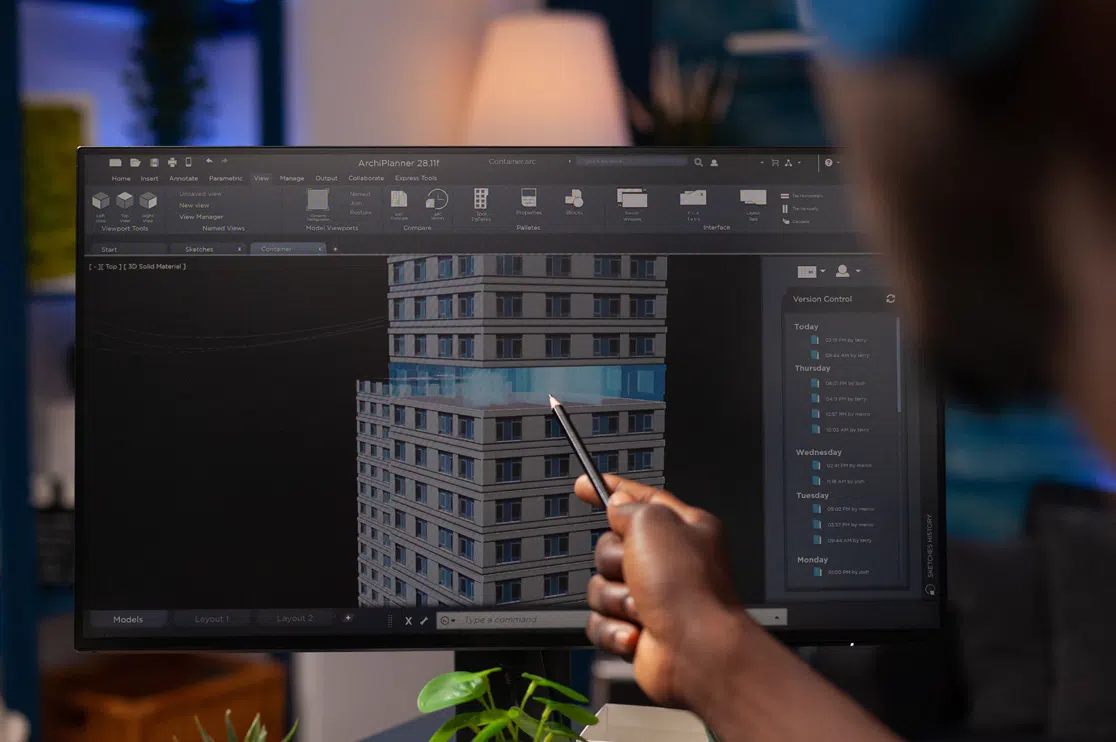Let’s ride the BIM Cloud!
The Architecture, Engineering and Construction (AEC) industry has been traditionally very fragmented when it comes to designing and constructing buildings. Many firms come together to develop a building and once that project is complete this unique team disbands to form another project team for the next building.
This industry needs a mechanism enabling us to work together, in real-time, using our information systems with the same ease of a project team that works for the same firm and sitting in the same physical location. Fueled by the technology building blocks of a cloud, Advance2000 now has an AEC Collaboration Hub.
This article will outline several scenarios firms are using to collaborate in new and exciting ways. We’ll also look at the “building supply chain” of partners that is starting to form in this Hub.
Project collaboration, the primary focus any field service management software and of this article, is the number one reason why firms are migrating to a cloud environment today.
Gone are the days where we have to transfer large models around and wait 2-4 days for design feedback on problems. Clients expect real-time feedback, projects are moving faster, and firms are looking at tighter margins. All these things require maximum efficiency and an AEC Collaboration Hub provides just that.
What is Cloud Computing?
Simply put cloud computing is turning Information Technology (IT) from a capital intensive business to a utility that can be consumed as needed from a pre-existing infrastructure.
Nicholas Carr nailed it when he compared modern cloud computing to the electric utility. In the past, companies would buy all the parts and labor to build and maintain their own power plant to generate electricity. They did this because they needed reliable electricity to run their business and there was no other option.
Over time, companies sprang up that would build and operate the power plants and sell their electricity to consumers. They were called a Utility. The same thing is now possible for Information Technology.
In the past, companies bought the parts and labor to build and maintain their own IT “power plant”. Over time, companies sprang up that would build and operate the IT power plants and sell their computing power to consumers. They are called Cloud Computing providers (e.g. IT utility). And Advance2000 is one such utility.
BIM Cloud
Building Information Modeling (BIM) has been embraced by this industry for design and construction of the built environment. A BIM cloud is a special purpose IT cloud (or Utility) that was applied to the problems of the AEC industry.
As a CIO, I built a BIM cloud to solve the specific issues surrounding Revit model collaboration. Revit is a good, multi-user design tool that works like a champ on a local area network (LAN) with all the designers sitting in the same office.
The problem with this scenario is that it doesn’t fit the operational needs of most firms, especially the larger firms working on large projects. We needed a way for designers to work on this model even though there were scattered all over the US and probably sitting in different firms.
Because people were used to working in Revit on a LAN, they wanted it to operate the same way over a Wide Area Network (WAN). It did not.
Computer performance was also a problem with each new version of your favorite BIM tool. I had 4gb of RAM, then I needed 8gb. I had 8gb, then I needed 16gb. Oh yeah, add in a new graphics card and a few more CPU cores too would be nice to boost productivity. The BIM cloud addressed both of these issues very well.
How Did the BIM Cloud Do That?
First, let’s look at computer performance improvement. A BIM cloud allows you to virtualize your desktop so that you can dynamically add computing resources very quickly and cost-effectively. Virtualization turns your hardware into a piece of software, allowing you to increase the utilization of your actual hardware. These concepts are very abstract, so I like to use concrete examples. Rather than giving someone a $3000 workstation that sits on his/her desk, virtualization allows you to buy a $20,000 piece of hardware and let 30 people run their desktops on that platform. If you looked at the desktop utilization of 30 individual workstations, you’ll be lucky if the utilization hits 15% because of all the time the user is NOT working on their computer. Virtualization allows you to pool resources and it’s very common to see 70-80% utilization of this $20,000 piece of hardware. Just like your firm, the higher your staff utilization the more efficient you are (and the more money you make). Likewise, when your hardware utilization is high, the more efficient you are (and the more money you save).
Second, let’s address this project collaboration need over geographically dispersed teams. If you’ve ever tried to move BIM data from point A to point B and back, you’ll be greatly disappointed in the performance. In fact, it gets real old, real fast. It sure would be nice if everyone could come and work physically in your office.
That’s exactly what a BIM cloud allows you to do. Because you can access your desktops remotely, all those desktops, applications, and storage you need to run your project can be co-located in the same data center. With a BIM Cloud, you have virtually co-located your project team.
OK this BIM Cloud was good and it solved a lot of problems, but there was still work to be done. While a BIM cloud is a more cost effective way to collaborate, it is not FREE. It still needs to be built and maintained.
Now if we want to do this collaboration with all the firms in the AEC industry, what are the practical limitations of doing this? Think about it, if I want to collaborate with another firm in my BIM cloud, I will have to have the capacity to house those outside team members.
In order to facilitate all the collaboration that is going on, each firm would have to create a tremendous amount of excess capacity to house their consultants. Most firms are just not setup to do this nor is that their business.
Enter Advance2000. Advance2000 is a 20 year old IT engineering firm that understands the challenges of the AEC industry and solves any conceivable collaboration problem. While there are several possible scenarios, the article will focus only on the ones that are happening right now in our data center.
Single Firm Collaboration – One Cloud
If you are a single firm with multiple offices across the US, you have a difficult time collaborating within your company. We can solve this problem by setting up a single BIM cloud for your firm to operate in.
This is the simplest scenario and is generally where a firm starts their cloud journey. Many firms extend their BIM Cloud to a full IT cloud, but more on that later.
As an example, you are doing a hospital and need a cloud for 20 people. We would setup a 500gb file server, 24gb, 2-core cloud desktops, required Revit applications (BYOL – bring your own license required by Autodesk), backups, and the appropriate network security to allow you to access this cloud from within your firm or from the internet when you are mobile.
Once built, we would work with your team to get your building models transferred (or you just dropbox them), provide you the login credentials, and you are off to the races.
I always tell firms to walk before they run. This scenario is the first step into cloud computing and I would consider it “walking”.
Multiple Firm Collaboration – One Cloud
You’ve been working as a single firm in your BIM Cloud for months and you love it. Now you want to invite other firms that are working on the same building project.
Wouldn’t it be great to have all disciplines working in the model at the same time? You get instant feedback when somebody moves a column or deletes something. Coordination is a snap when you are all working on the same infrastructure.
This is an easy problem to solve – just make your cloud bigger to accommodate your consultants. Find out which applications they will need to run (Revit?), install appropriate sized cloud desktops, and provide logins. Since there are different firms involved now, many have asked me how to prevent other firms from changing your model.
Using the standard Microsoft Server ACLs (Access Control Lists), it is very easy to make directories invisible to everyone but authorized eyes. Or you can make a directory read/write by the owning firm and read-only by the other firms that will only be linking to your model. The file permissions can be as simple or complex as your project requires. In this scenario you are “jogging”.
Multiple Firm Collaboration – Multiple Clouds
Let’s continue this craziness. You are an architect and you have your own BIM cloud in the Advance2000 data center. In the previous scenario, you invited an engineering firm to join your cloud to work on a project.
That engineering firmed liked the experience so much; they want to get their own cloud. In this scenario, each firm in the design/construction project has their own cloud. How now will they work together?
The first thing we’ll look at is where the project data (i.e. models) are going to be located. Generally, we would place it into the lead firms cloud.
So in this example if the architect is the lead firm, we would carve out some “secure space” in their cloud and allow all the project stakeholders to map to this directory from their respective clouds. This web of project connections could get pretty complex, but it is no different than what is currently taking place today on any given project.
The difference in this cloud scenario is that firms do not have to move project models around. They are stationary and to access them, the firms only need to map to the drive.
And this file mapping is happening at LAN speeds ranging from 1000mbps – 10,000mbps compared to internet speeds of 5mbps – 20mbps. This provides project performance over a wide geography as good (or better) than what they current experience if their project team was physically located in one office. Now you are “running” in this scenario.
Collaboration Hub Partners
As one can imagine, when you setup an environment where companies can collaborate in real-time, new business opportunities are created for everyone in this new ecosystem.
Existing AEC service providers are adding these collaboration strategies to their business models (e.g. Caddforce-Randall Schultz, The Mendicant Architect-Darrell Smith, and Next Wave Technology-Paul Benbow).
BIM Staffing (AEC Catalyst), Autodesk Reseller/Reprographics (TPM), Training (CAD Training Online), and Sustainable Design Services (Greenwizard) are all starting to join forces with Advance2000 to add value to the “cloud collaborators”.
The phenomenon that is happening is much like you see in the physical world. When you have a waterway, or a new road, or a light-rail system installed, you see businesses pop up all along these arteries.
The same is happening in our data center. Advance2000 has created an artery for collaboration that is causing new businesses to pop up and new sources of revenue for member firms.
Conclusion
This short essay just touches on the basics of BIM Clouds and the AEC Collaboration Hub. I hope it provides thought-provoking information that allows us to stop fighting with technology and get on with the business of designing a better building, much more efficiently.







 How AI BIM Modeling Shaping the Future of Residential Construction?
How AI BIM Modeling Shaping the Future of Residential Construction?  How BIM Services Enhance Collaboration, Design Choices, and Project Efficiency for Architects? – A Guide
How BIM Services Enhance Collaboration, Design Choices, and Project Efficiency for Architects? – A Guide  How is Artificial Intelligence in Construction Design Transforming Architectural Landscape?
How is Artificial Intelligence in Construction Design Transforming Architectural Landscape?  BIM Coordination Benefits for Contractors in the Preconstruction Stage
BIM Coordination Benefits for Contractors in the Preconstruction Stage